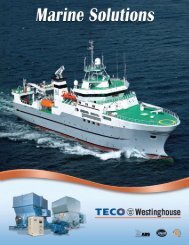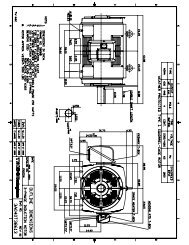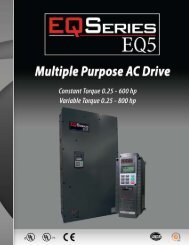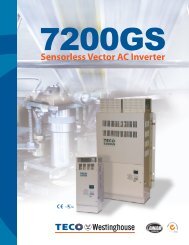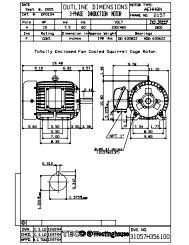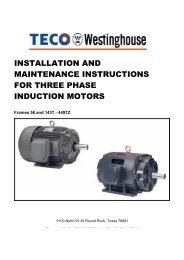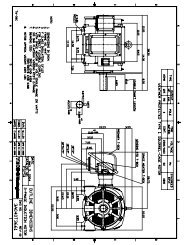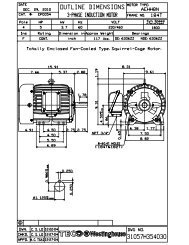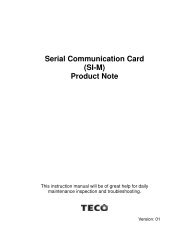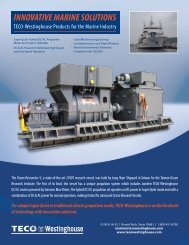EQ7 Series Instruction Manual - TECO-Westinghouse Motor Company
EQ7 Series Instruction Manual - TECO-Westinghouse Motor Company
EQ7 Series Instruction Manual - TECO-Westinghouse Motor Company
Create successful ePaper yourself
Turn your PDF publications into a flip-book with our unique Google optimized e-Paper software.
F50 to F52<br />
Electronic Thermal Overload Protection for Braking Resistor<br />
(Discharging capability, Allowable average loss and Resistance)<br />
These function codes specify the electronic thermal overload protection feature for the braking resistor.<br />
Set the discharging capability, allowable average loss and resistance to F50, F51 and F52, respectively. These<br />
values are determined by the inverter and braking resistor models. For the discharging capability, allowable<br />
average loss and resistance, check with the manufacturer of the braking resistor and set the function codes<br />
accordingly.<br />
Depending on the thermal marginal characteristics of the braking resistor, the electronic thermal overload<br />
protection feature may act so that the inverter issues the overheat protection alarm even if the actual<br />
temperature rise is not large enough. If it happens, review the relationship between the performance<br />
index of the braking resistor and settings of related function codes.<br />
The standard models of braking resistor can output temperature detection signal for overheat. Assign an<br />
"Enable external alarm trip" terminal command THR to any of digital input terminals [X1] to [X7], [FWD]<br />
and [REV] and connect that terminal and its common terminal to braking resistor's terminals 2 and 1.<br />
Calculating the discharging capability and allowable average loss of the braking resistor and configuring<br />
the function code data<br />
When using a braking resistor, check with the resistor manufacturer about the resistor rating and then configure<br />
the related function codes.<br />
The calculation procedures for the discharging capability and allowable average loss of the braking resistor differ<br />
depending on the application of the braking load as shown below.<br />
- Applying braking load during deceleration<br />
During normal deceleration, the braking load decreases as the speed slows down. In the deceleration with<br />
constant torque, the braking load decreases in proportion to the speed. Use equations (1) and (3) given below.<br />
- Applying braking load during running at a constant speed<br />
Different from during deceleration, in applications where the braking load is externally applied during running at a<br />
constant speed, the braking load is constant. Use equations (2) and (4) given below.<br />
Braking load (kW)<br />
Braking load (kW)<br />
Time<br />
Applying braking load during deceleration<br />
Time<br />
Applying braking load during running at a constant speed<br />
• Discharging capability (F50)<br />
The discharging capability refers to kWs allowable for a single braking cycle, which is obtained based on the<br />
braking time and the motor rated capacity.<br />
Data for F50<br />
Function<br />
0 To be applied to the braking resistor built-in type<br />
1 to 9000 1 to 9000 (kWs)<br />
OFF Disable the electronic thermal overload protection<br />
During deceleration:<br />
Discharging capability (kWs) =<br />
During running at a constant speed:<br />
Braking time (s) x <strong>Motor</strong> rated capacity (HP) x 0.75<br />
2<br />
Discharging capability (kWs) = Braking time (s) <strong>Motor</strong> rated capacity (HP) 0.75<br />
Equation (1)<br />
Equation (2)<br />
When the F50 data is set to "0" (To be applied to the braking resistor built-in type), no specification of the<br />
discharging capability is required.<br />
4-68



